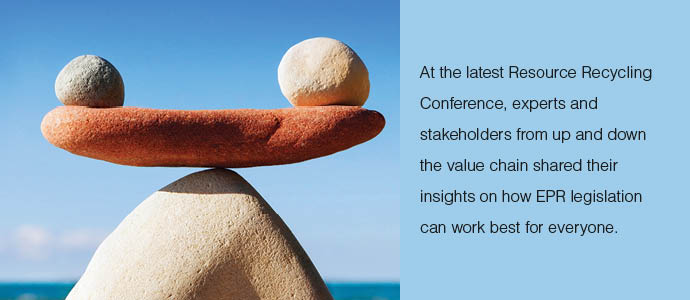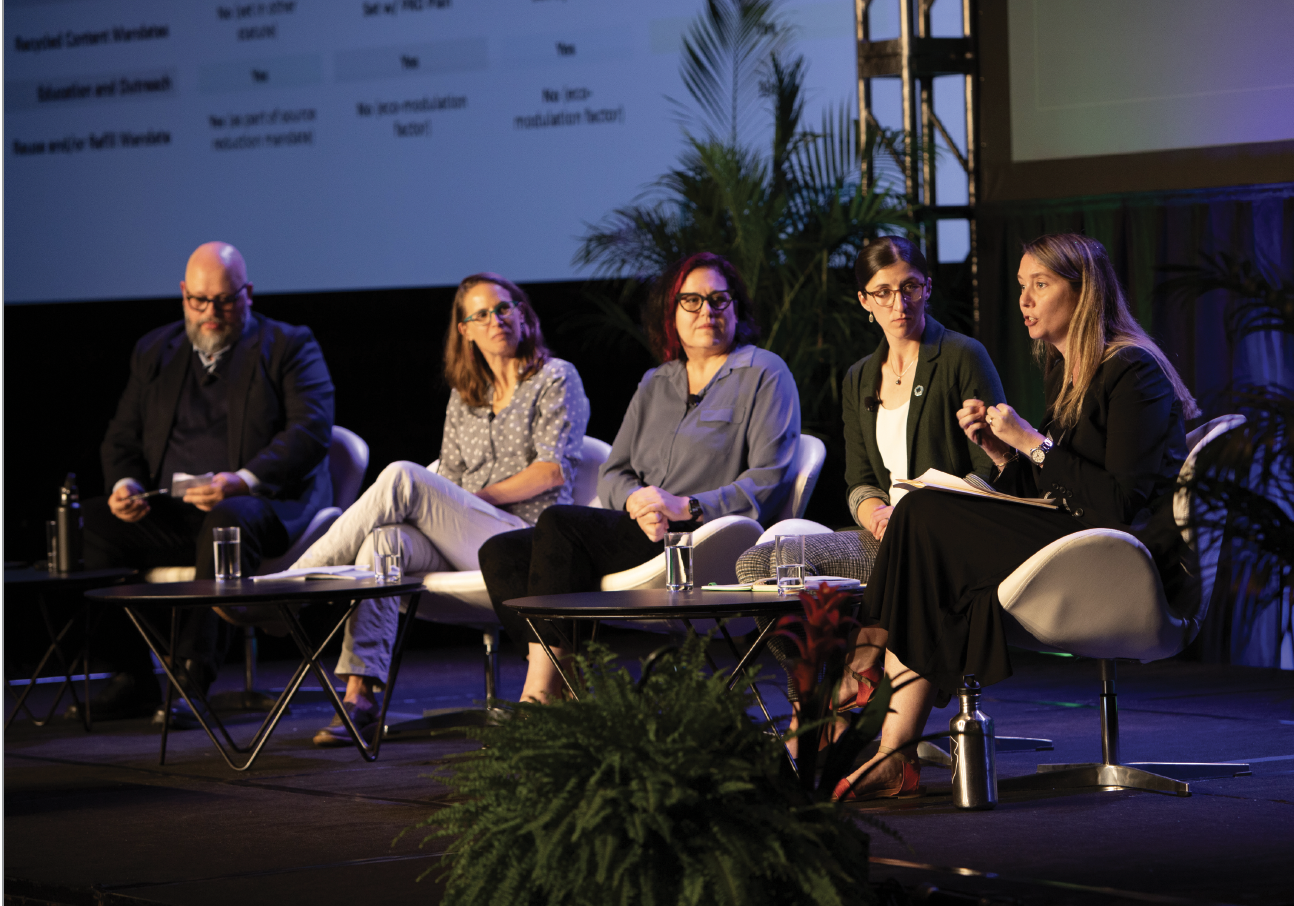
This article appeared in the October 2023 issue of Resource Recycling. Subscribe today for access to all print content
Conference attendees may have been expecting a boxing ring when stakeholders got on stage to talk about plastic and extended producer responsibility, but instead they got a message of hope, progress and civil disagreement on film, chemical recycling and labeling.
The session, “Plastic Tensions Within Extended Producer Responsibility,” took place as part of the 2023 Resource Recycling Conference held in Orlando, Fla. in August.
Panelists were Kate Bailey, chief policy officer at the Association of Plastic Recyclers; Anja Brandon, associate director of U.S. plastics policy at the Ocean Conservancy; Megan Daum, vice president of sustainability for American Beverage; and Jennifer Ronk, sustainability and advocacy manager at Dow.
The session was moderated by Dylan de Thomas, vice president of public policy and government affairs at The Recycling Partnership.
De Thomas opened by explaining that “as we’re talking about the environmental outcomes that we want from extended producer responsibility (EPR), lots of different stakeholders are coming to the table and saying, ‘Hey, this feeds into it. This is an impact from packaging. This is an impact from an externality that’s caused by plastic packaging being put into the world.’ So other goals are being layered on top of these extended producer responsibility bills.”
Those added goals are often sources of tension, but speakers also discussed the common values bringing stakeholders together.
What is the value of EPR?
Bailey said after spending more than a decade trying to bring curbside recycling to Colorado, she had an “aha” moment. “I can’t spend the rest of my life going community by community trying to solve the same problem, which is the money,” she said. Instead, EPR is the solution.
“EPR fundamentally is how we fund recycling across the country in a way that we never have done before,” she said. “We’ve never done it in a consistent, coordinated, dedicated, ongoing way.”
Brandon said Ocean Conservancy approaches EPR from the lens of the “ocean plastic pollution crisis,” seeing EPR “as a way of getting to these improved environmental outcomes that we all want.”
“We need a system-change policy,” she said. “We cannot do this by putting Band-Aids on the system or working on the perimeters anymore. We recognize we need to tackle this system head-on and that’s really what EPR gives us the opportunity to do.”
Ronk said Dow has supported EPR when it’s “fair, flexible and solves the problem,” and when it puts more material into the system.
“We want to make sure that money is going into the system to fix the system, make it better, cover those operational costs,” she said. “To be fair, we’re also selling recycled content, so we want to make sure that the system works so that we can get the materials that we would like to sell to our customers.”
Getting more material in the system is also a selling point for Daum, who said, “We need strong recycling systems, not recycling systems that are getting left behind.”
“What EPR does is it shifts the funding from municipalities and taxpayers to the producers who put the packaging on the marketplace, so that there is that kind of secure system of funding from all the way from access, education, collection, processing to end market,” she said.
Mixing EPR and other goals
However, few of the recent EPR laws and bills for packaging in the U.S. consisted of only EPR statutes. Many also contained source reduction provisions, reuse goals, additive bans or recycled-content mandates. De Thomas asked panelists if it’s better to have a single, inclusive bill or to work out each issue through separate legislation, and opinions ran the gamut.
Ronk said, “As somebody who really wants to see how we can accelerate making the system work better while being as thoughtful as possible, I think sometimes simpler can be better.”
Brandon pushed back, saying that additional features such as source reduction or design criteria “actually all help our recycling system too, so they’re not actually in conflict. They’re very much connected and can be viewed that way.”
She called EPR a “yes, and” opportunity – a “foothold into the system.”
The structure a producer responsibility organization lends to the system can be used to help accomplish other goals and outcomes, Brandon added.
“For plastics, we know that we are quite simply making too many single-use plastics, right? Our system cannot handle the sheer volume of single-use plastics we’re putting out,” she said. “So we’re requiring that source reduction, we’re both driving towards those better environmental outcomes we want and we’re improving our recycling system at the same time by reducing a lot of those materials that end up being contamination.”
Daum said although combining goals does make sense, doing so can also make it harder to pass bills, and “that is something that is very frustrating to me because I want to pass EPR.”
She pointed to Washington’s recent failure to pass the WRAP Act as an example. It would have combined EPR for packaging with a deposit return system, among other things.
“That was a good bill and I’m really frustrated that that didn’t pass,” she said. “I think one of the reasons it didn’t pass is because we’re not working and growing together anymore. We keep adding stuff and it’s, ‘Wait, well, I just can’t get on board with that,’ so that does concern me.”
Bailey, who attended the most recent round of United Nations Global Plastic Agreement talks in Paris, said she’s “come to appreciate this is a long-term societal commitment to change the way we deal with plastics on the same scale as we address climate.”
EPR is a big part of the solution, she said, but it’s also “not our only time up at bat.”
“There’s going to be a long-term shift, but [EPR] is something we know how to do today to fix a huge problem,” Bailey said. “There are things that we’re going to need to come back and fix again and again as we move on this very complex issue.”
The labeling question
“If you want to work on a problem in which you will make no one happy all of the time it’s labeling,” Bailey said on stage.
She said that she thinks the resin identification code (RIC) can coexist with better recycling labeling. “We also need to disconnect the resin ID code from the recycling chasing arrow,” she said, drawing applause from the audience.
Ronk agreed with Bailey, noting that QR codes seem to be a viable alternative, and Brandon added that she thinks EPR can be used to transition away from most labeling by requiring that items be reusable, recyclable or compostable.
“It takes time to get there, and so labeling is critical in that in-between time as we transition,” Brandon said. “That uniformity, separating it out from the RIC, all of those are critical pieces. But at the end of the day, to get to a circular economy, that means that you have a destination that is not the black bin. You’re going in the green bin, you’re going in the blue bin, or you’re going in a purple unicorn fairy bin … or whatever it is that we have for reuse that we’re still building out and envisioning together.”
Another layer to the labeling question, Bailey added, is that it’s important to recognize that companies sell across many state lines, so labeling changes are tricky to do state-by-state.
“I’m as frustrated as we all are and want to change it, but we also need to recognize that this is a larger system we’re playing in,” she said.
Chemical recycling tensions
The panelists all agreed that more innovation and new recycling technologies are needed, but also cautioned against going all in on something before it’s proven at scale.
Daum said that because producers will be funding the system, “any sort of processing needs to have proven itself at scale and shown its environmental implications, the strength of end markets, the actual purchase of material.”
Chemical recycling might be best used for plastic durables, Bailey suggested, because 55% of plastics are used for non-packaging applications. She also cautioned against diverting limited resources away from mechanical recycling, which has already proven effective.
Language in Oregon’s EPR bill is a good middle ground, she said, because it laid out the parameters any new technology would have to meet and “the door wasn’t wide open and the door wasn’t shut.”
“It was like, ‘Here’s what we need you to do,’ and it was a clear direction: If you can innovate in these circumstances that meet these outcomes that we’ve all agreed upon, great. Let’s go for that,” she said. “I think that’s how we can walk that line in the legislation and build in a path and allow for innovation to move in those spaces.”
Brandon added that because EPR often brings data collection and transparency to recycling systems, in the future it will be easier to evaluate new technologies.
“We can just really shine a light and get the data and information that we need about a lot of these systems and a lot of the technologies that we just don’t have right now,” she said.
Overall, reflecting on the past year of EPR activity and the years to come, the speakers said their biggest takeaway was the need for collaboration between all stakeholders. Bailey also noted that celebration is necessary, as she and many others have been talking about EPR for packaging since she started in the recycling sector in 2003.
“It is here and that is worth celebrating and recognizing that it is happening and it has been a long time coming,” she said. “I know this panel was called ‘tensions,’ and I’m sorry we didn’t fight more. Maybe that would have been more interesting. But I think that’s the point. That’s where we are in the conversation – we more agree than we disagree.”
Marissa Heffernan is the staff reporter at Resource Recycling. She can be contacted at [email protected].
This article appeared in the October 2023 issue of Resource Recycling. Subscribe today for access to all print content.

